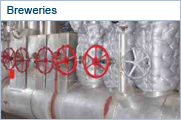New building costs
Despite the importance of insulation, it is normally at the bottom of the list when it comes to the budget priorities of new building projects. Insulation activities take place during the most hectic part of the construction process: between installing plants and machinery and production start up of the factory. The old principle “No insulation is better than bad insulation”, from the days when energy costs were relatively light, is outdated in the sense that no insulation is not a realistic option from the point of view of energy and the environment. Bad insulation is not an acceptable solution either, neither from the point of view of an energy usage nor maintenance. Incorrectly applied or badly maintained insulation can result in huge costs in terms of maintenance, leakage, equipment replacement and even interruptions to production.
Maintenance costs For the purposes of operations or maintenance, it is necessary in some cases that insulation can be removed from certain parts of the machinery on a regular basis. This can be done using removable shields around valves and flanges for example. But in some cases, such as for turbines, pumps, manhole covers, instrumentation etc, it is worth considering insulation blankets. The advantage is that the blankets can be made-to-measure, so that the blanket takes on the shape of the object are far as possible. It therefore provides optimum insulation that is easy to remove and replace, as often as required. Insulation blankets are a perfect example of an investment that may be higher initially but will reap rewards in terms of significantly lower maintenance costs.
Reliability of heating plants Our experience in the field has taught us that the available space for heating equipment is becoming more and more limited. This is due in part to factors such as building costs. A consequence of this is that, despite regulations, ventilation is often inadequate. Heat in engine rooms is principally generated by heat retention in pipes and ancillaries, by far the most important heat source. High temperatures in engine rooms are bad for the lifespan of electronic equipment in switching boxes. This leads to equipment failure and jeopardises the reliability of plants and equipment. Insulating ancillaries with Thermatras® insulation blankets is a first step which can always be followed by installing ventilators.
Personnel costs Absenteeism due to ill-health of one member of staff equates to between one and a half to two and a half times their salary. This amount is made up of loss of revenue and replacement or extra workload on colleagues. If the sick employee is not reintegrated into the organisation, this may lead to increases in disability premiums for all employees (in large organisations). Good health and safety policies lead to better working environments. A healthy work climate has a positive influence on reduction in disability and absenteeism due to sickness. This contributes directly and indirectly to increases in returns. Risk Inventories and Evaluation and Plans of Action are important instruments for charting operating risks and finding solutions for them. If the ambient temperature rises above 40°C there is inevitably a risk to health and appropriate measures must be taken. Apart from threats to health, high temperatures can also constitute a fire hazard.
The Law Under the Environment Protection Act, heating plants are regulated in terms of their burning methods, safety and energy conservation. The Environmental Inspection Agency monitor companies to ensure that they comply with regulations. The measures that companies are required to take depend on their annual energy consumption. The agency determines whether energy saving measures can be taken, in which case the agency can require you to carry out an energy assessment. A Plan of Action for measures to be taken has to be drafted. The investment for carrying out these measures should be recovered within five years. If a company is in violation of the environment regulations, the agency can apply sanctions, such as a fine or administrative enforcement. The agency may also revoke the company’s environmental license. In the future, the European Union is likely to become more stringent in terms of environmental regulations.
Environment costs Environmental costs and damage to the environment are difficult terms to express in figures with any accuracy. Often short-term effects are emphasised and damage to the environment only manifests itself in the long term. The value of nature and the environment is difficult to make concrete and, because of this, it is often underestimated. In the future, growing importance will be attached to the principle “The polluter must pay”. Being environmentally conscious and having a neutral effect on the climate is being rewarded by subsidies on a growing scale, while polluting the environment is being punished with ever greater sanctions.
Maintenance costs For the purposes of operations or maintenance, it is necessary in some cases that insulation can be removed from certain parts of the machinery on a regular basis. This can be done using removable shields around valves and flanges for example. But in some cases, such as for turbines, pumps, manhole covers, instrumentation etc, it is worth considering insulation blankets. The advantage is that the blankets can be made-to-measure, so that the blanket takes on the shape of the object are far as possible. It therefore provides optimum insulation that is easy to remove and replace, as often as required. Insulation blankets are a perfect example of an investment that may be higher initially but will reap rewards in terms of significantly lower maintenance costs.
Reliability of heating plants Our experience in the field has taught us that the available space for heating equipment is becoming more and more limited. This is due in part to factors such as building costs. A consequence of this is that, despite regulations, ventilation is often inadequate. Heat in engine rooms is principally generated by heat retention in pipes and ancillaries, by far the most important heat source. High temperatures in engine rooms are bad for the lifespan of electronic equipment in switching boxes. This leads to equipment failure and jeopardises the reliability of plants and equipment. Insulating ancillaries with Thermatras® insulation blankets is a first step which can always be followed by installing ventilators.
Personnel costs Absenteeism due to ill-health of one member of staff equates to between one and a half to two and a half times their salary. This amount is made up of loss of revenue and replacement or extra workload on colleagues. If the sick employee is not reintegrated into the organisation, this may lead to increases in disability premiums for all employees (in large organisations). Good health and safety policies lead to better working environments. A healthy work climate has a positive influence on reduction in disability and absenteeism due to sickness. This contributes directly and indirectly to increases in returns. Risk Inventories and Evaluation and Plans of Action are important instruments for charting operating risks and finding solutions for them. If the ambient temperature rises above 40°C there is inevitably a risk to health and appropriate measures must be taken. Apart from threats to health, high temperatures can also constitute a fire hazard.
The Law Under the Environment Protection Act, heating plants are regulated in terms of their burning methods, safety and energy conservation. The Environmental Inspection Agency monitor companies to ensure that they comply with regulations. The measures that companies are required to take depend on their annual energy consumption. The agency determines whether energy saving measures can be taken, in which case the agency can require you to carry out an energy assessment. A Plan of Action for measures to be taken has to be drafted. The investment for carrying out these measures should be recovered within five years. If a company is in violation of the environment regulations, the agency can apply sanctions, such as a fine or administrative enforcement. The agency may also revoke the company’s environmental license. In the future, the European Union is likely to become more stringent in terms of environmental regulations.
Environment costs Environmental costs and damage to the environment are difficult terms to express in figures with any accuracy. Often short-term effects are emphasised and damage to the environment only manifests itself in the long term. The value of nature and the environment is difficult to make concrete and, because of this, it is often underestimated. In the future, growing importance will be attached to the principle “The polluter must pay”. Being environmentally conscious and having a neutral effect on the climate is being rewarded by subsidies on a growing scale, while polluting the environment is being punished with ever greater sanctions.











